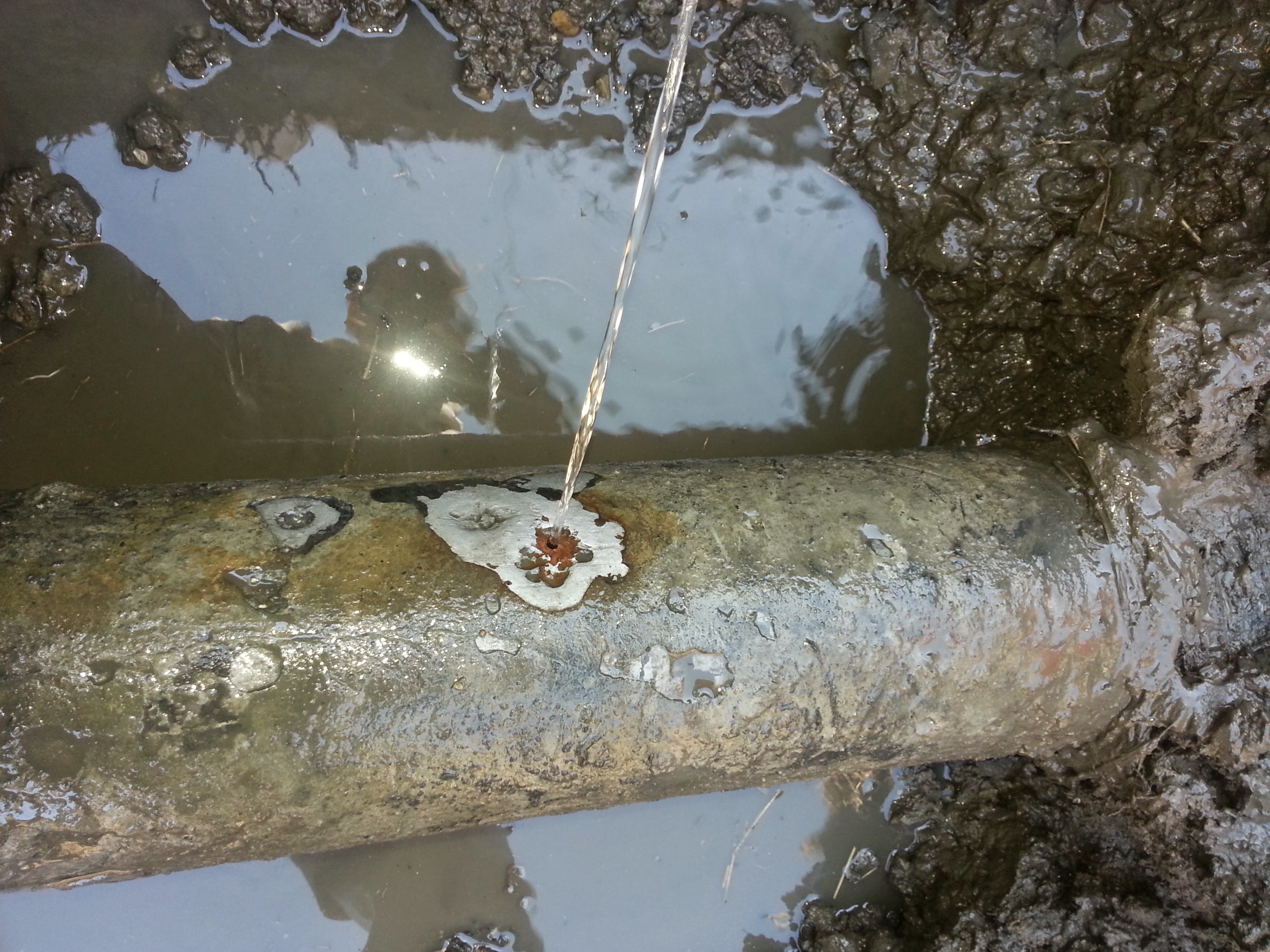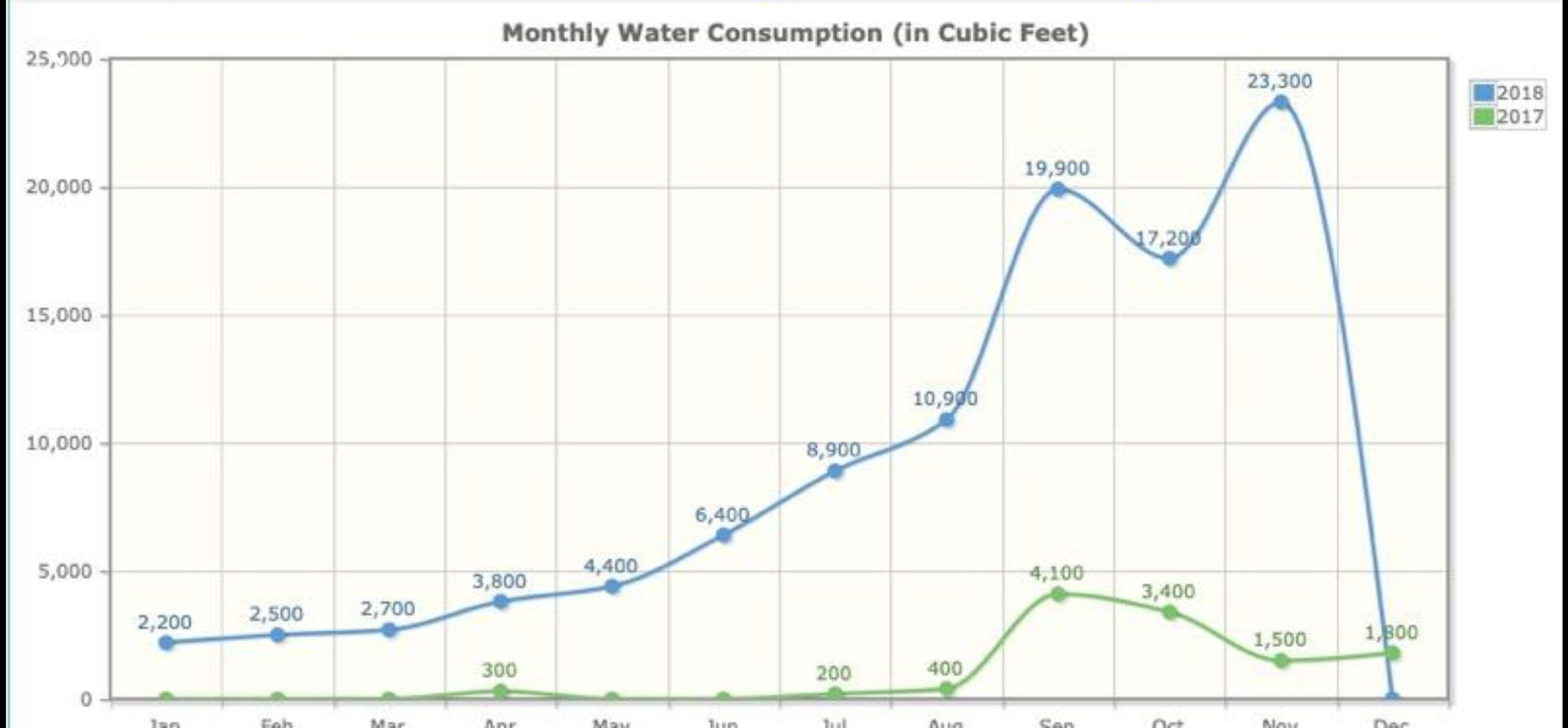
Undetected leaks can cost the homeowner big time. I recently was called to a residence in a gated community where their water bill had been consistently high. These homeowners actually share a water meter that cover several homes. The conversation with the homeowners started with a text message asking me if I thought the water bill was a bit high. He sent me a copy of their water consumption rated in cubic feet, and it stated that they had used 23,000 cubic feet of water in 1 month, about 176,000 gallons. To put that in perspective, that is enough water to fill a large swimming pool, or cover an entire acre of ground with 6 inches of water.

This is a copy of the usage over time. The green line represents the previous years consumption. It turns out that they had lost enough water to supply a small neighborhood park.
How do you know you have a problem?
Often the first sign to a homeowner is a ridiculously high bill. If this happens to you, don’t wait, either contact a competent sprinkler repair man, plumber or even the water department. Most water departments are more than willing to take a look at the meter reading and give you advice on your best course of action. They wont offer repair services though, if the problem is on your side of the meter, it’s your problem.
Another way is to be observant. Water running through pipes makes a very distinct sound. If you have never noticed the sound of water running through pipes, simply flush a toilet or turn on your washer and wonder the house listening. You will likely have to flush the toilet several times, but eventually you will likely notice the sound. If you hear that high pitched sound and no water is being used, you may have a problem.
And finally, you may just be the “lucky one” and the water will surface or come rushing out of the ground all at once. I know your are not lucky when you have main line leaks, but it beats finding the problem on your water bill.
Over the years I have heard countless stories about huge expenses because of undetectable leaks. One such story was a property I was managing. I got a frantic phone call, because their winter bill was over $2000. It turns out that their main line was set in gravel and they developed a leak that was flowing at over 5 gallons a minute. The sad thing is that it never surfaced, even though I could feel vibration of the water flowing when I inspected the property.
How to find the problem
The first step to finding the problem is to know where your water main lines are located. This can be as simple as locating your water meter, then simply walk in a strait line toward your home. You most likely just walked the path of the main line, since most contractors choose the shortest route when installing main lines.
The next step is to determine where the obvious connections are. These are locations where the main line connects to another line or valve, like a stop and waste or hose bib, the meter its self, or the physical connection to the house. If you are lucky, those will be the only connections.
listening for trouble
Your ears are one of the best tools for locating leaks. I typically use a stop and waste key (curb key) to help channel the sound, by placing the stop and waste key on the exposed pipe at the meter, the stop and waste its self or any other exposed pipe. You can then place your ear against the metal of the key and hear the water movement as well as determine how close you are to the leak by the intensity of the sound.
Check out this link to learn more about using the stop and waste key, it is a video on youtube that shows how to operate a stop and waste.
Visual inspection
Checking the pipe where it is exposed (meter, stop and waste), if you see standing water, chances are that is the spot you are looking for. If you come across a spot that is more wet or damper than the rest of the property, that is a great clue as well. If there are no obvious signs of leaking, you can also look for settling of the ground or turf.
Check the meter
Checking the meter is definitive proof that there is a problem, but be aware that some water departments have restrictions to who is allowed access to the meter. Before actually touching the meter or even exposing it, you may want to ask the water department if you have the right / privilege to access it. Just be aware that if you access the water meter whether you have permission or not, you will be liable if anything gets damaged.
Intuition
Sometimes there are no obvious signs and you simply have to follow your intuition. I know it is unprofessional, but sometimes you simply need to start by using your best guess or intuition.
Isolation
If you have more than one connection to the main line (like a supply to sprinklers), you can isolate the separate sections to eliminate likely problem areas. If you close an isolation valve and the leak stops (i.e. the meter stops turning) that would determine that the leak is down stream of that particular isolation. This is a great way to narrow the possible affected areas.

Howdy! I could have sworn I’ve visited this web site before but after going through
many of the posts I realized it’s new to me.
Anyhow, I’m definitely delighted I found it and I’ll be book-marking it
and checking back often!
I absolutely love your blog and find a lot of your post’s to be just what I’m looking for.
can you offer guest writers to write content available for
you? I wouldn’t mind creating a post or elaborating on a lot of the subjects you write regarding here.
Again, awesome site!
Hello everyone, it’s my first pay a quick visit at this web page,
and piece of writing is really fruitful designed for me, keep up posting such articles.
Spot on with this write-up, I seriously believe
this site needs a great deal more attention. I’ll probably be returning to see more, thanks for the information!